-
Posts
543 -
Joined
-
Last visited
Content Type
Profiles
Forums
Gallery
Events
Posts posted by 6ohiocav
-
-
Hey Mike,
I have a few halyards to install, and then the braces, and then I dare say, the rigging (at least as far as I am going with it) will be complete. I'll have to do some final tying off at the pin rails and then create some rope coils. In the meantime, I need to figure out what to do with the boats and the hammock rails.
-
CLEWLINES AND SHEETS
While I have been working on prototypes of my scratch-build ship’s boats, I noted that we now have a new format to the site. Looks great. Thanks to the ADMINS. I can’t imagine the time it takes to keep all of this up to date.
Since I hit a snag on what to do with the clewlines and sheets for a ship rigged without sails, I broke down and secured a copy of Peterssons book “Rigging Period Ship Models” and found an answer in the diagram on page 49. Using that as a guide, I rigged my topsail clews and sheets. An adequate solution.
-
Mike,
I am looking forward to hearing how that India Ink works for you.
I am also very excited to follow along with this monumental build.
Good luck and smooth sailing my friend.
-
I totally agree with Nick. I did the upper shrouds and ratlines on my Niagara build, doing that on the bench and then pinned the yards. I then stepped the mast, and worked on the lower shrouds and ratlines before attaching the course yard. You want to maintain as much room to attach shrouds and ratlines as possible.
-
SPANKER THROAT HALLIARD AND TOPPING LIFT COLLAR, COURSE LIFTS, TOPSAIL LIFTS, BACK STAYS
More work on the main mast. And I hit a snag with the Spanker Throat Halliard Collar. I installed the collar around the top of the spanker mast ok. I actually cut a grove in the spanker mast to allow the collar to sit in before I installed it. Good planning. But I forgot to seize the double block to the Spanker Gaff. With the Spanker Gaff already pinned in place, and having already fully rigged it, I was reluctant to UNDO everything just to seize a block.
Therefore, I was forced to seize that block on the ship. The seizing rope wraps around the base of the gaff and passes through two holes in the jaws (I did put the holes in before installing). That is now a very busy place. I used a very long strand of .012 black rope so that I could pull it far away from the gaff, and was able to tie a whipping knot that wrapped around the double block, and pulled it tight to the gaff.
I rigged the Topping Lift Collar with .018 rope for the Spanker Boom
.
I rigged the Topsail Lifts and belayed them to the pin rail.
I rigged the Course Yard with .018 and belayed them to pre-installed tackles at the base of the main mast.
I also belayed a number of the loose running rigging ropes, including the t’gallant clew line and sheets. Those pass through the fairlead on the shrouds and belayed to the pin rail.
I belayed the Course Truss lines.
I also tied off all of the back stays with the small kit supplied deadeyes.
I am getting pretty close to finishing off the rigging I chose to do. I have not included any large scale photos lately, so here you go.
-
-
Like Tony, I try and tie all of my seizings by hand, using the standard "whipping" knot that Sicard demonstrates. The zip seizings soaked in CA stand out to much for my taste. I do however use his zip seizings on those impossible knots, where you can't get good access, and since they are by nature, buried somewhere, you really can't see the CA seizings. It helps in a pinch.
-
CATHARPINS PRACTICUM
I thought I would share with you my method of installing the catharpin on the lower shrouds of my main mast. I have seen other modelers use this method. The Niagara plans call for thimbles for attaching the lanyard. I elected to use the kit supplied brass rings that I blackened.
Since this has to be tied on to the model, it is a bit tricky. Using elongated pieces of .018 black rope (as per the plans), you can pull the ends far enough away from the shrouds to tie the knots.
The pictures show the process that I chose. I don’t know if this is the correct way, but it worked from me and at this scale looks good.
As an aside, I have come to a better understanding how and why a sailing ship’s rigging is engineered the way it is. Together with the futtock shrouds and the ratlines, the catharpin, when added to the main shrouds, really tightens up the entire system. It is rather incredible how everything works so well together.
- Tim Curtis, Elijah, jbshan and 5 others
-
 8
8
-
-
-
Mike
Your build just gets better & better. You mentioned stuff being in the way for the gall & boom. Would it have helped (or even been possible) to do that earlier in the process?I think this is the nature of the beast. I don't think there is another way. The catharpin and futtock shrouds were the problem. But they need to be done before anything is added since they are much more complex. If I had added the spanker gaff before the catharpin, that would have been a real pain.
-
Mike,
If you can get your ship to the Mississippi, and sail it up the Ohio, I will pick it up in Marietta. Actually, I wish we lived closer so that we could collaborate in person.
Thanks a lot for your experiments on the hammock rails on your build. I am following closely and taking a lot of notes.
-
COURSE YARD AND SPANKER BOOMS
Winter Weekends in North East Ohio are good for modelling. I was able to accomplish a lot.
I dressed up the course yard. I seized all of the blocks, attached the foot ropes and jackropes. After doing all of that on the bench, I pinned the yard to the mast… my last yard!
I then rigged up the course yard sling and truss. As stated, the block and tackles (with .018 lanyards) for the truss were seized to the yard before raising. All I had to do was to run the lanyard. I will belay it to the deck later.
I then turned my attention to the Spanker Boom and Gaff. I previously seized all of the blocks and thimbles. I also tied up a knotted foot rope. I used a .018 rope and tied a serious of half hitch knots and seized it to the boom.
Attaching the boom and gaff to the spanker mast was very tricky. I decided to pin the throats to the spanker mast. The first challenge was drilling a hole in the whopping 1/8 diameter dowel. I used a micro drill bit and decided to use a .026 wire for the pin. I marked and drilled the holes for the spanker mast before I mounted it.
I also drilled the holes on the spanker jaws.
Lining them up however to attach the boom and gaff was another challenge. The boom was easier. The Gaff was one of those @^*&$ moments. Too much “stuff” in the way.
I also tied on a rope parrel with small eyebolts (the smallest I could twist up). I tied one end with a whipping before I installed the booms. I had to tie the other end on the model. Again, a very difficult procedure. I used a .018 rope. Threading the end around the spanker mast and through the small eyebolt on the other side was difficult. I used a long length of rope so that I could pull the ends away from the eyebolt to tie a whipping. Once tied, I carefully pulled the end to slide the knot to the eyebolt and tightened up the entire assembly. This took most of the morning, and alas, when done, YOU CAN'T EVEN SEE IT!
Oh well, I know it is there, but in a few days, I will forget it.
Once the boom and gaff were pinned in place, I was able to rig the topping lift for the boom. The blocks in the tree were previously installed. I used a .018 tan rigging rope. I also attached the tackles and belayed them to eyebolts in the waterway.
I then rigged the spanker gaff. Again, I used a .018 tan rope. I temporarily tied the ends off on cleats on the railing.
It is starting to look like a sailing ship.
-
-
-
Maybe some 1/64 hammocks on the ends. I think that each side of the Niagara has two runs of hammock rails (break in the middle for stairs and boarding ladder). That would be a total of 8. Then a canvas cover for entire run, and perhaps a square stock of wood with canvas cover in between, which the plan suggests.
Make sense?
-
MAINMAST STAYS
I attached all of the mainmast stays. The main and spring stay are rigged with closed hearts and tied with lanyards to a heart seized to the foremast and forward bit. I used .018 tan rope for the lanyards.
The topsail (middle) stays are rigged with bulleyes, route through thimbles tied to the foremast, and tied with lanyards to bulleyes attached to eyebolts on the deck. I used .012 rope for the lanyards.
The t’gallant and royal stays are routed through thimbles on the foremast. The t’gallant stay is rigged with a double 1/8 block and attached to a tackle on the foremast tree. The Royal is rigged with a kit supplied ring, and attached to an eyebolt with .008 lanyard on the foremast tree.
I think you can see most of this on the photos.
Every layer of rigging I add to the ship really enhances the image of this great ship.
Next up, attach spanker booms and course yard.
-
Hey Mike,
I have to mount the course yard, and both spanker booms, which I will be doing this week. Then attach all of the loose stays and running rigging. That should complete the rigging. I then have to work on the anchors, decide on what to do with the hammocks/rails, and last but not least, the ship's boats. The plan is to scratch build the boats on ribbing, and discard the kit supplied layered method.
Any suggestions on the hammock rails, canvas material, methodology, etc?
-
Hi Joel,
I actually tried to create eye splices with the .008 rope, and to be honest, I could not find a pin tip small enough to split the fibers well enough. I also had to do it under a magnifying glass while the rope was clamped to a small vice. I cannot even imagine how one would do that on a ship at this scale. And considering that each of the lower shrouds would require 30 splices X 2 and considering there are 4 in total, that would be 240 splices.
I therefore have to agree with your admonitions.
-
- jablackwell, mikiek, JerryTodd and 5 others
-
 8
8
-
Thanks Mike for the encouraging words.
Steve, I understand the question clearly. The end knots are single half hitches with a spot of CA to hold it together. I tie the half hitch such that the rope that leaves the knot heading to the first shroud line wraps "underneath" the knot to create the proper shape of a hanging ratline. I do the same at the end. I hope this makes sense. If you don't do this correctly, the rope will have an inverted hang to it. I discovered this by trial and error.
- Elijah, Canute, Tigersteve and 1 other
-
 4
4
-
Mike,
Thanks for looking in.
I have found that it just takes a lot of time to tie hundreds of knots. Once I get the shrouds done, and the last course of ratlines, hooking up the remaining stays that are hanging off the mast should go pretty smartly, at least they did on the foremast. I can almost see a bit of light at the end of this long tunnel.
-
LOWER MAST SHROUDS, STAVES, FUTTOCK SHROUDS, AND YET MORE RATLINES
I reached yet another milestone – I stepped the main mast.
I seized the deadeyes to the end of my shroud lines using my jig, and then lashed them to the channel deadeyes with .012 lanyards (tan rope).
I then lashed the upper and lower staves using black sewing thread. The staves were made of cherry stripwood that I milled and finished in tung oil.
I then worked on the futtock shrouds. I used 3mm brass hooks (blackened) and .025 rope. I seized the hooks on with a whipping. I wrapped the loose end of the shroud lines around the upper stave and seized the end to a shroud line with my black sewing thread.
Then, MORE RATLINES!
I am obviously getting a little better at doing this. The work on the mainmast is much cleaner than the foremast. Practice does help.
Of course, it is still time consuming. These simple exercises on the starboard side took all weekend, and I have to do it all again on the port side.
- Elijah, mtaylor, Ryland Craze and 3 others
-
 6
6
-



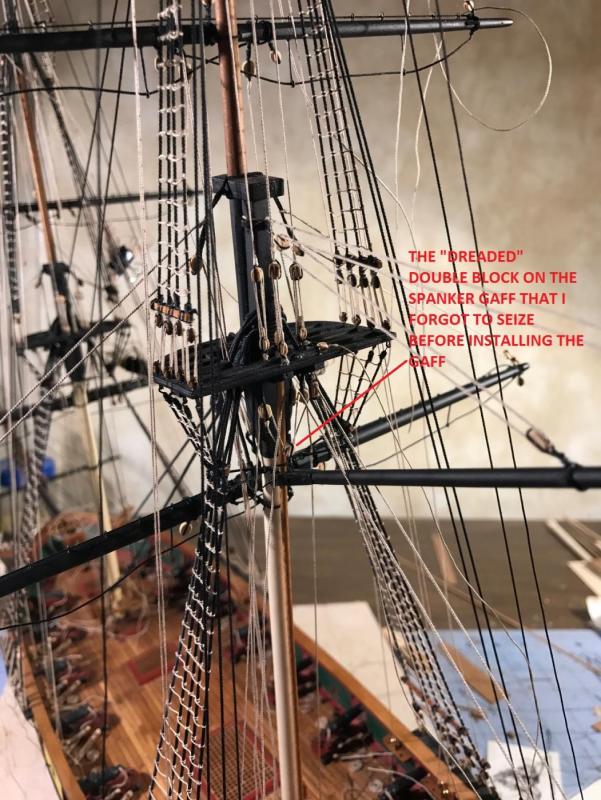
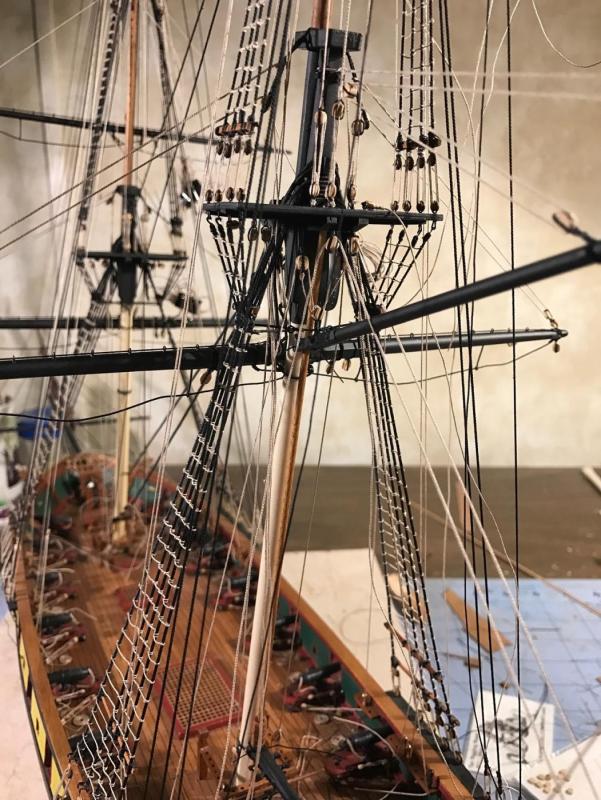
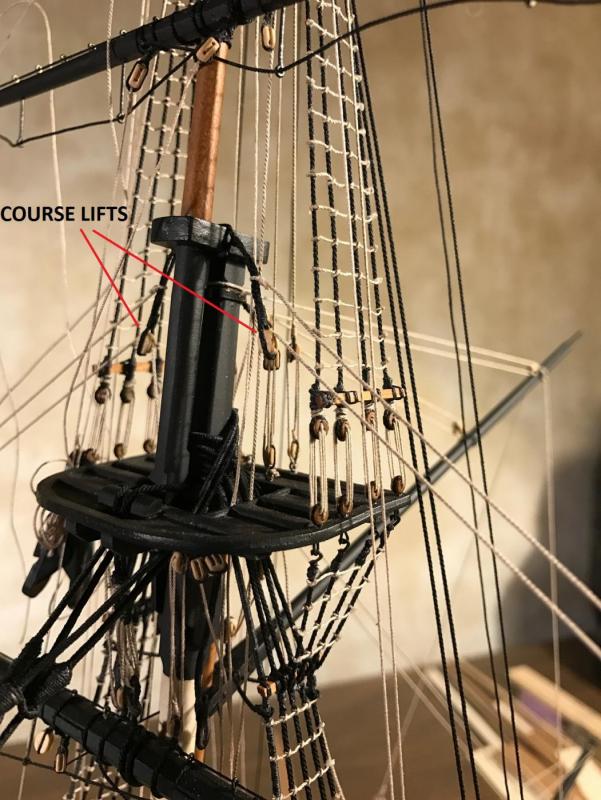
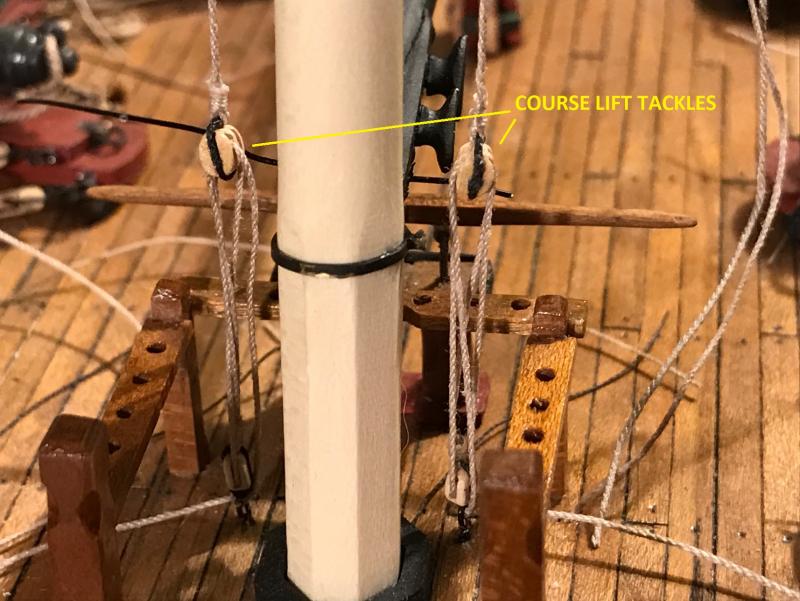
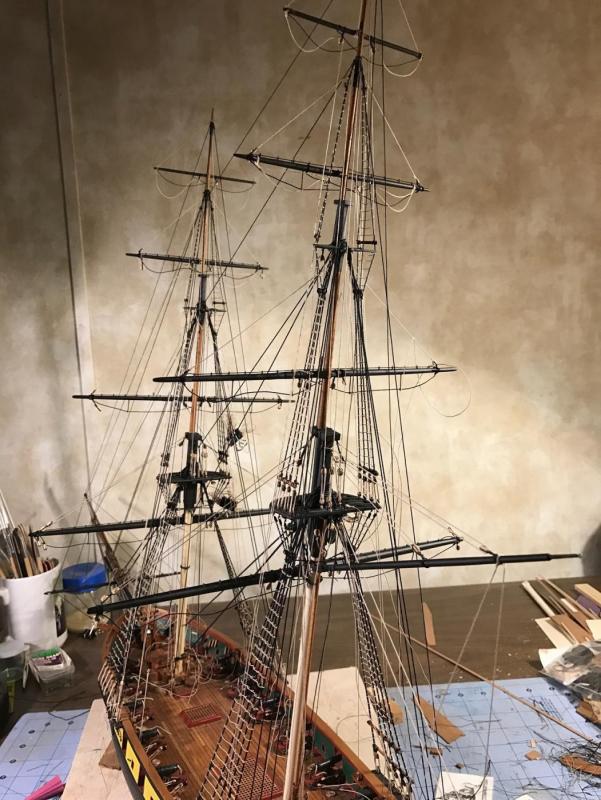
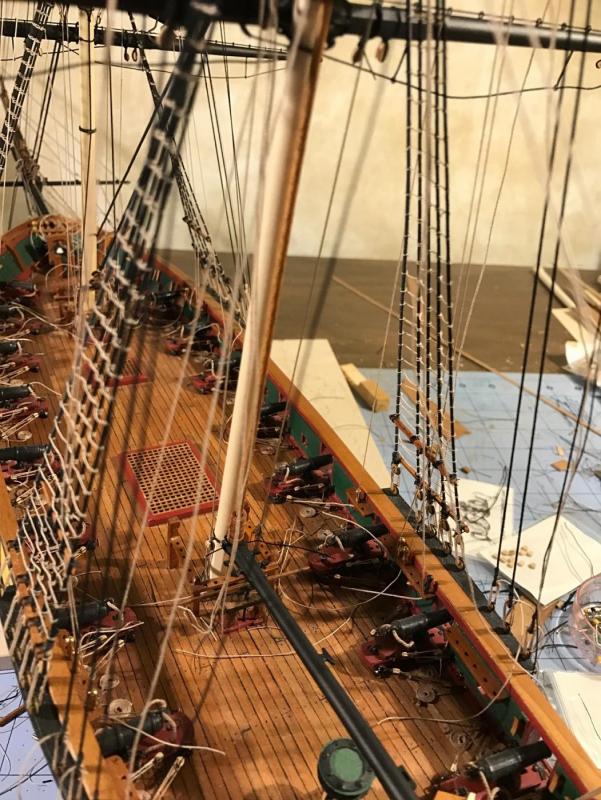
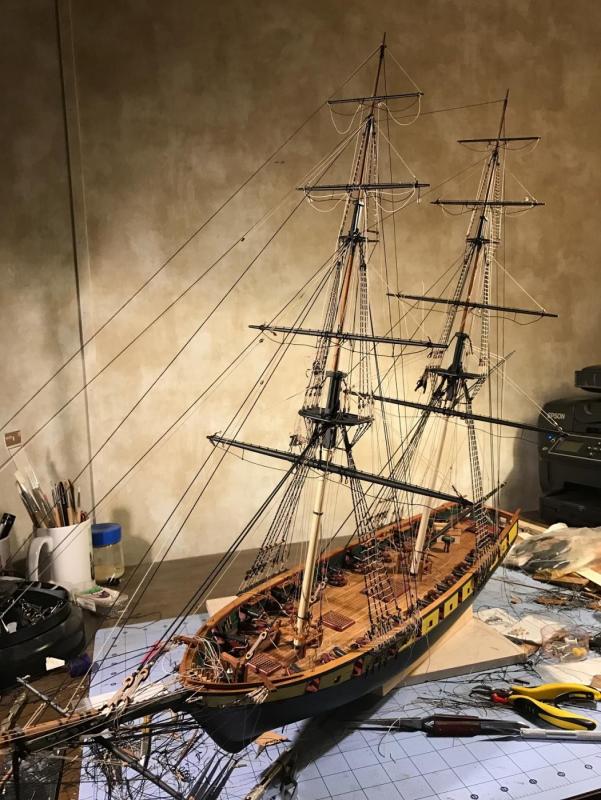
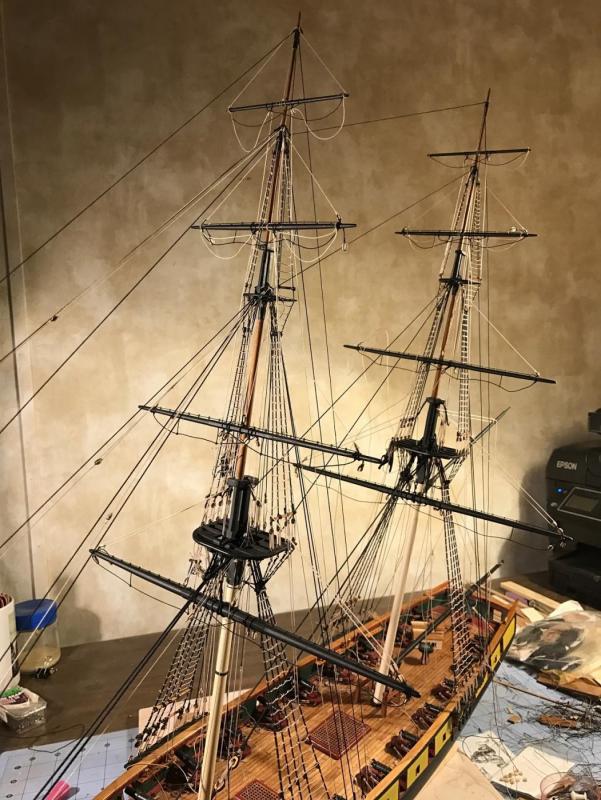
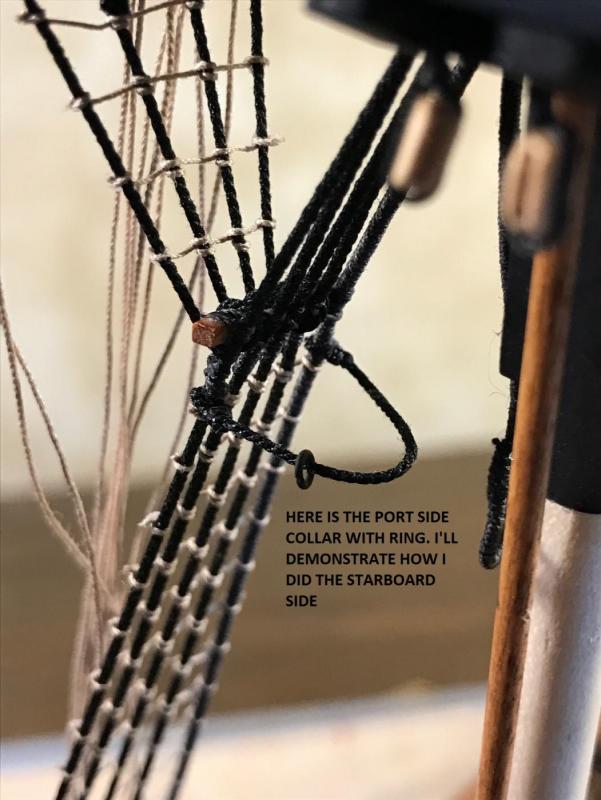
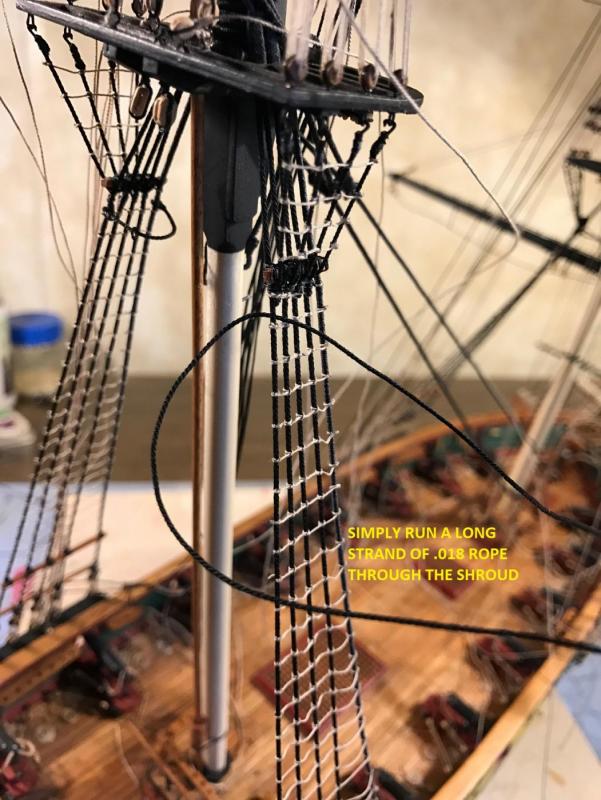
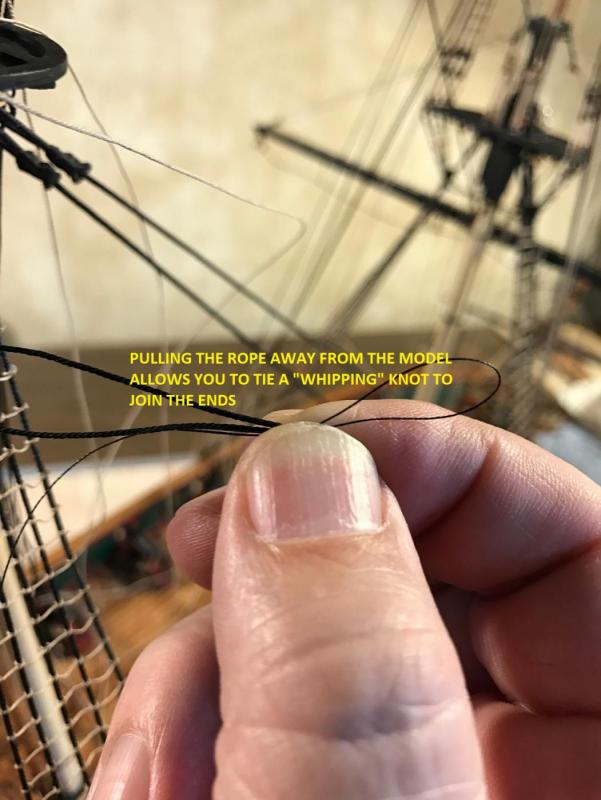
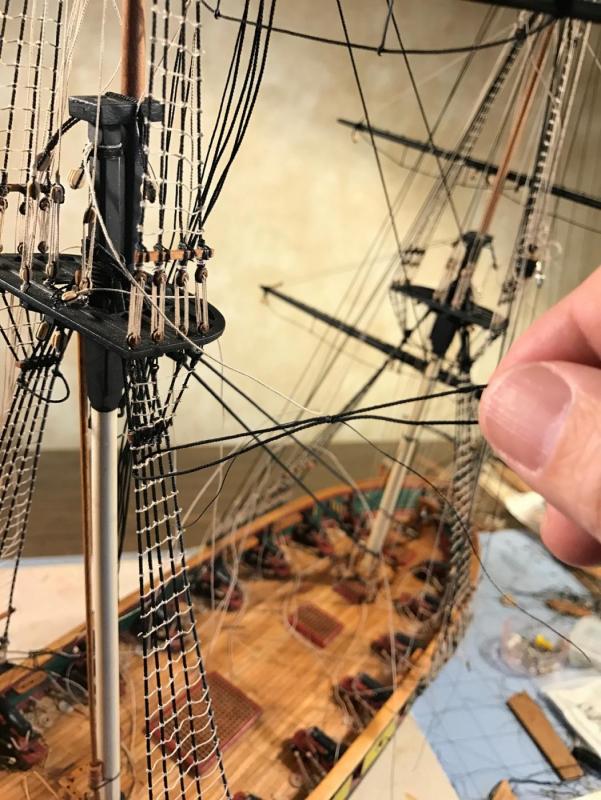
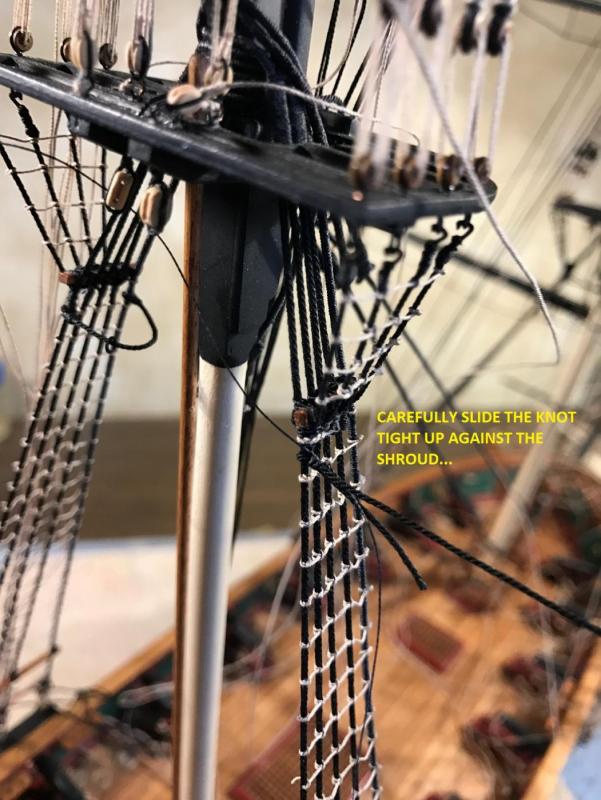
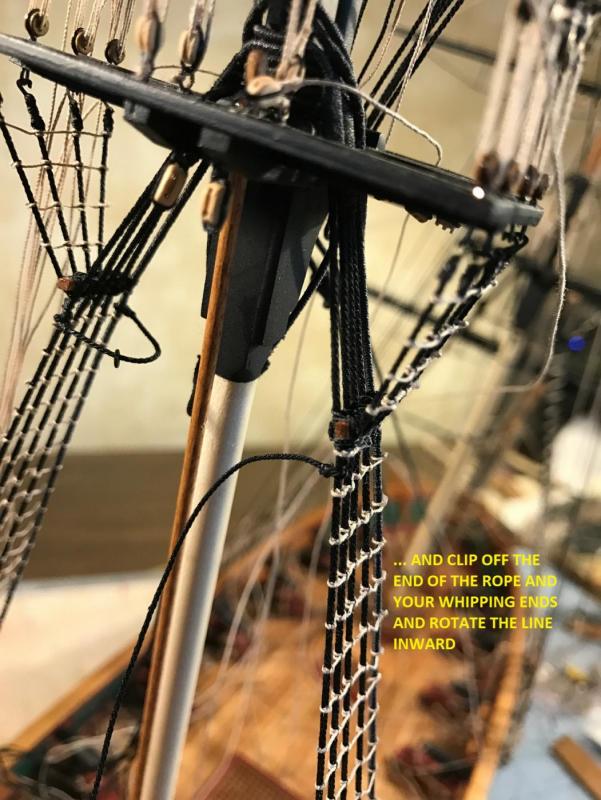
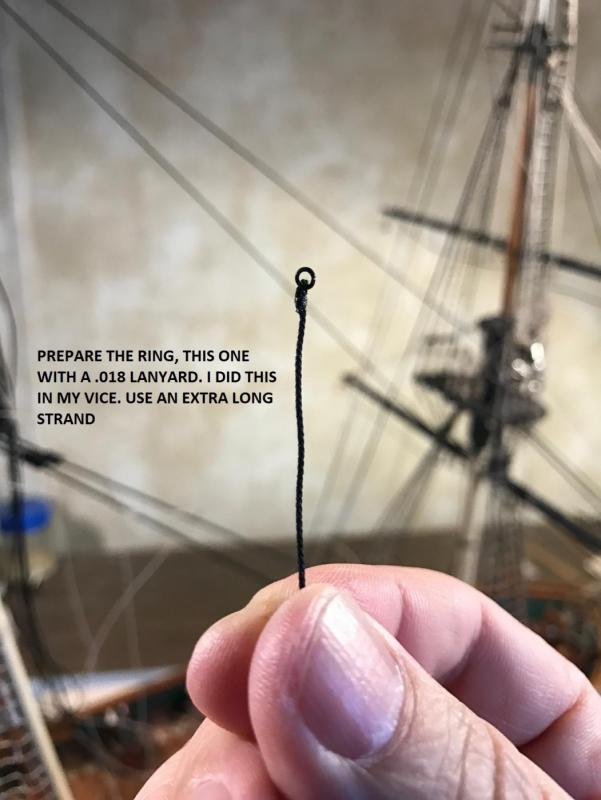
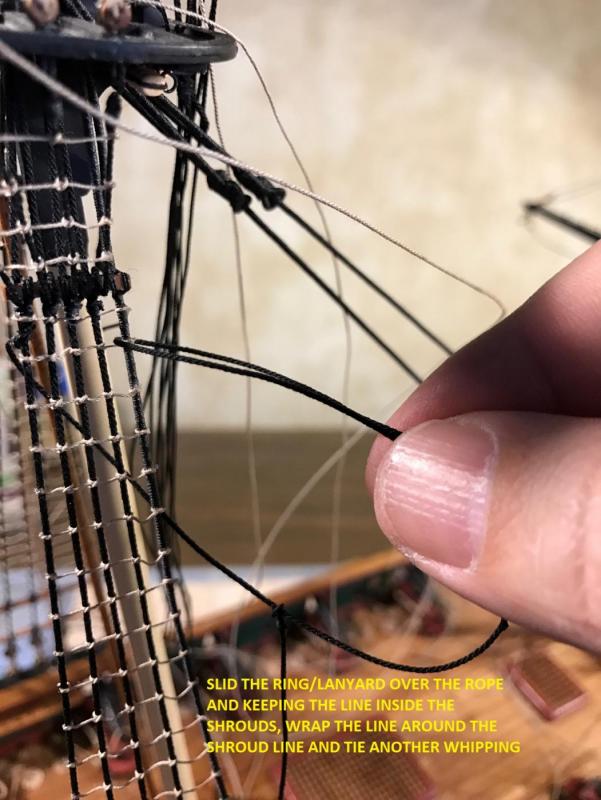
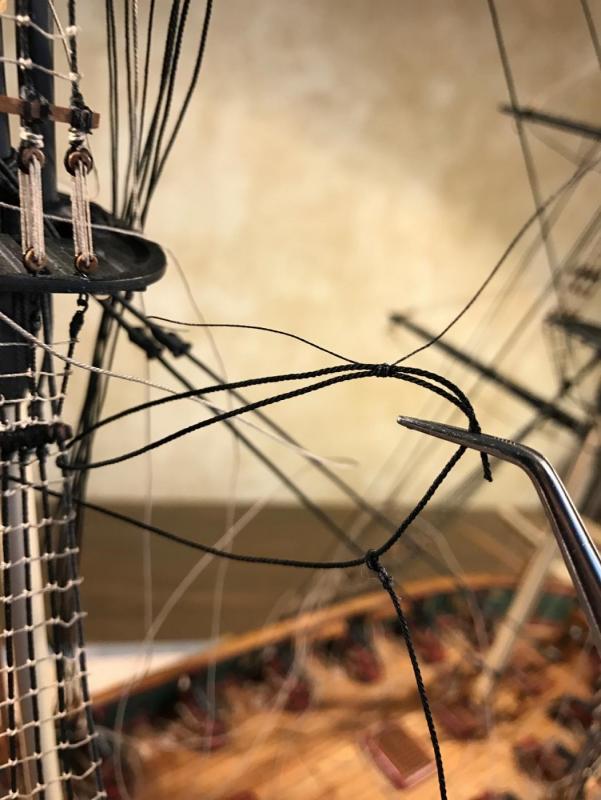
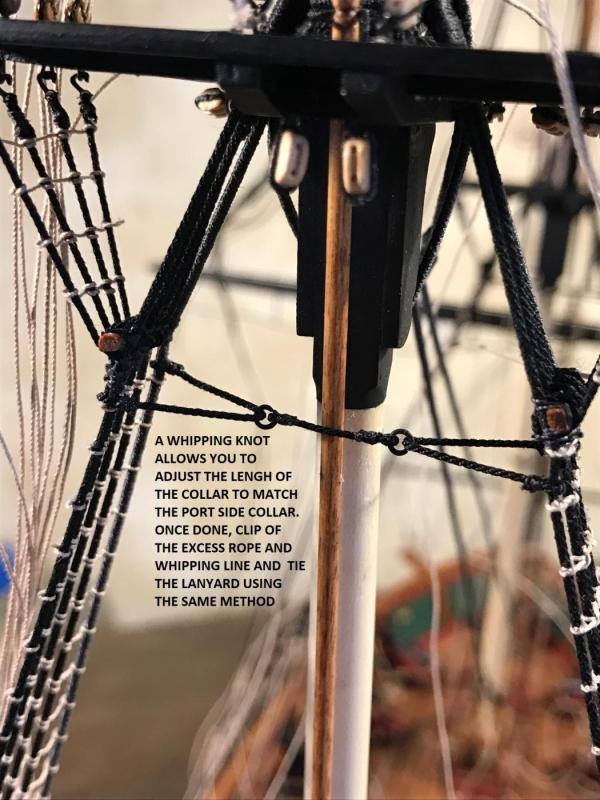
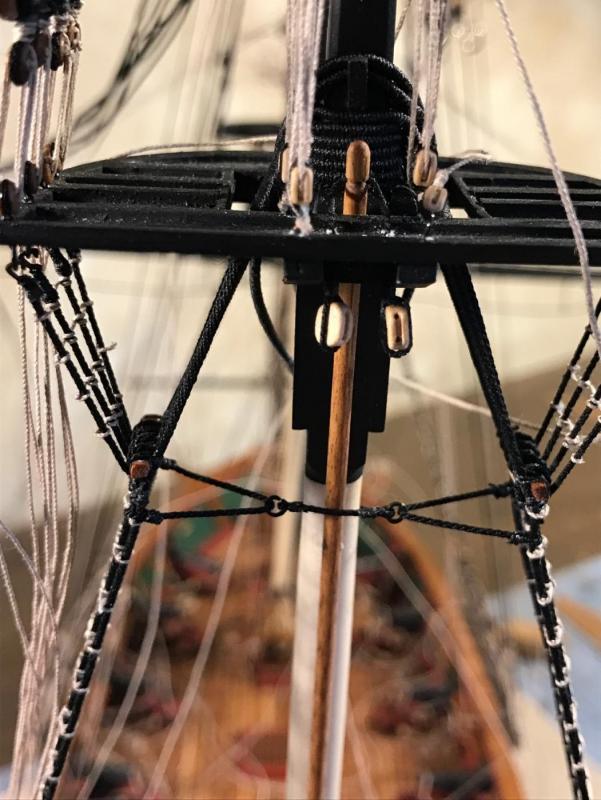
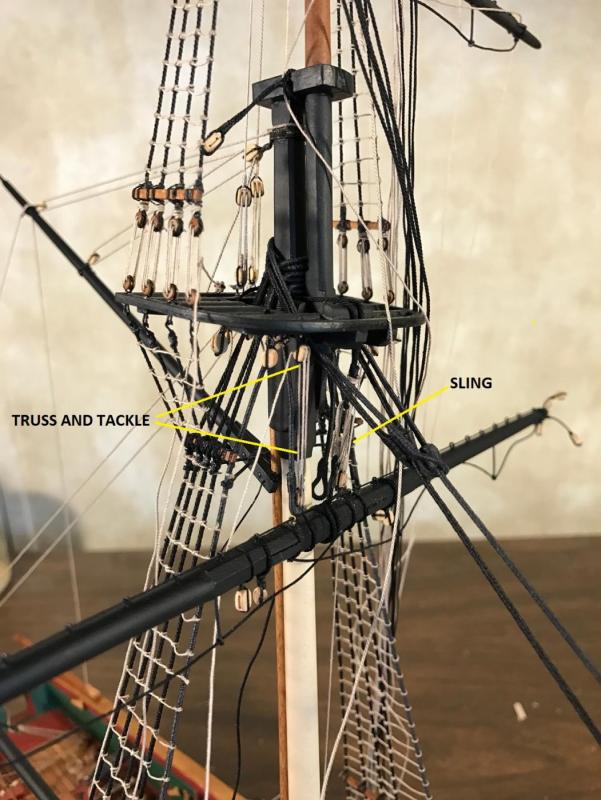
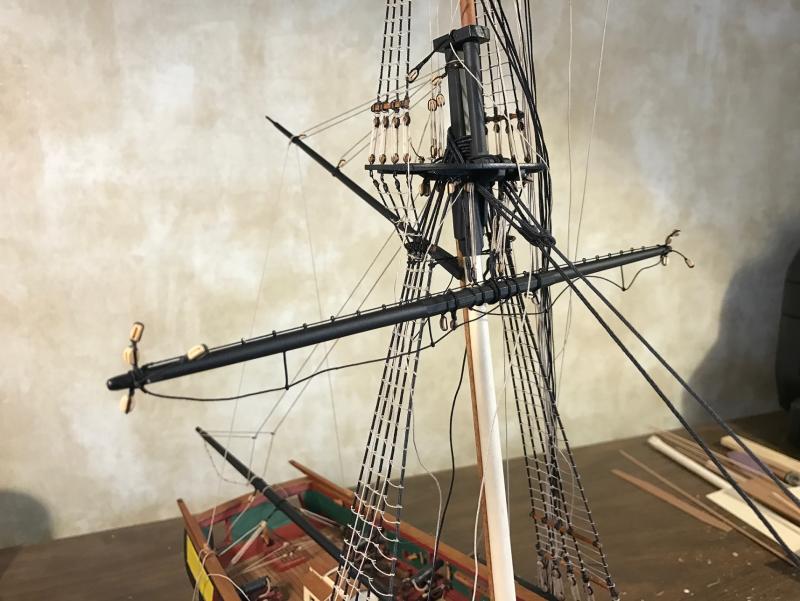
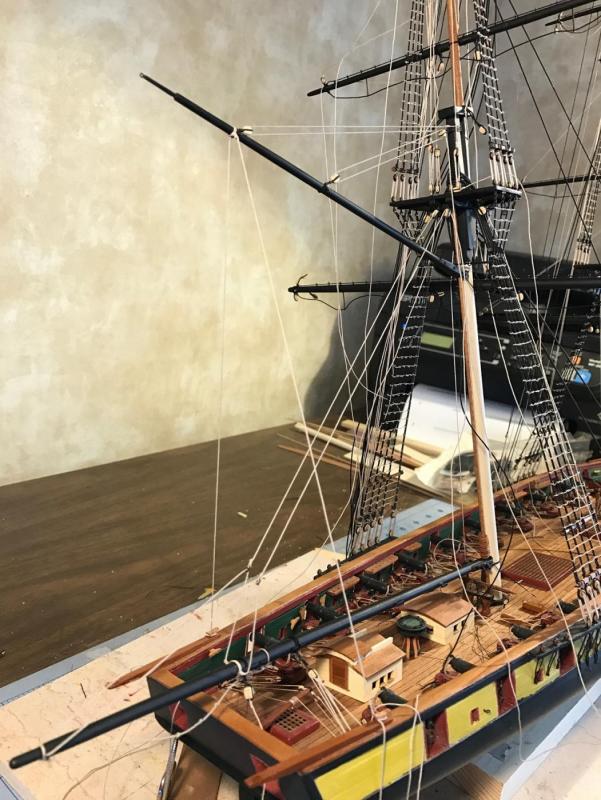
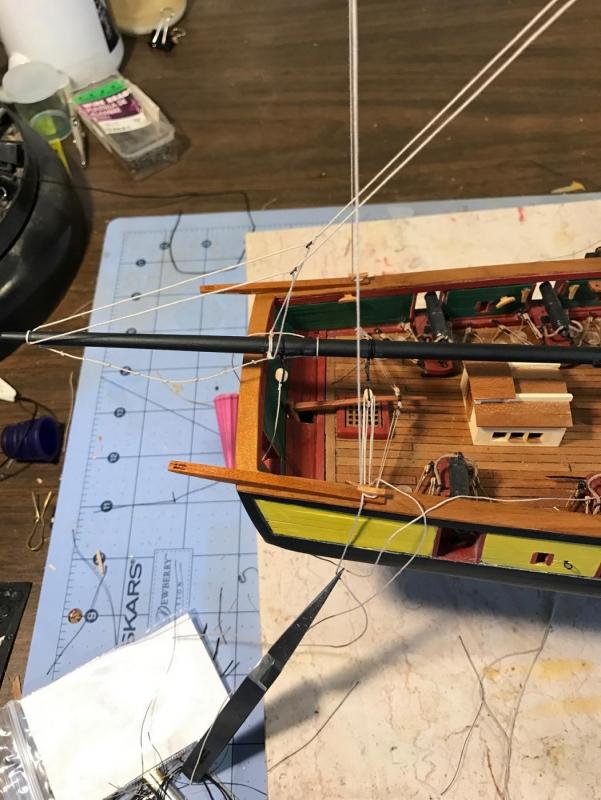
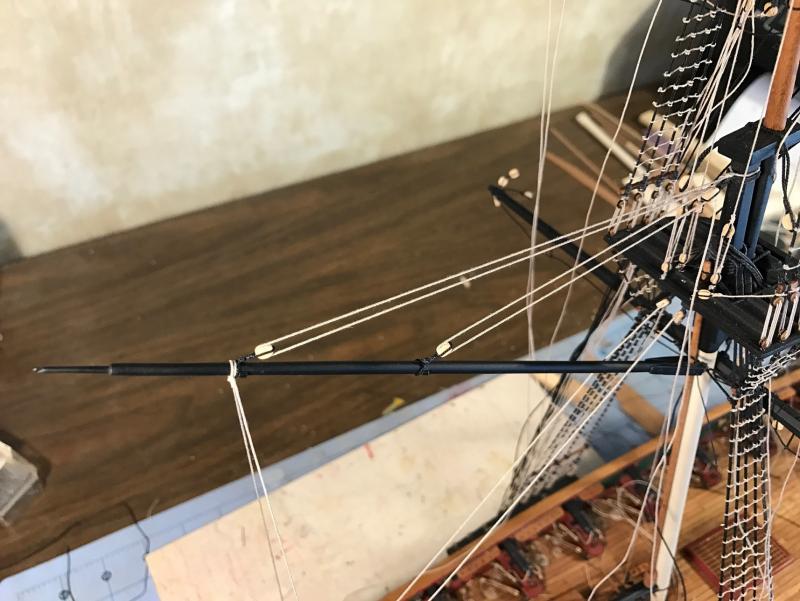
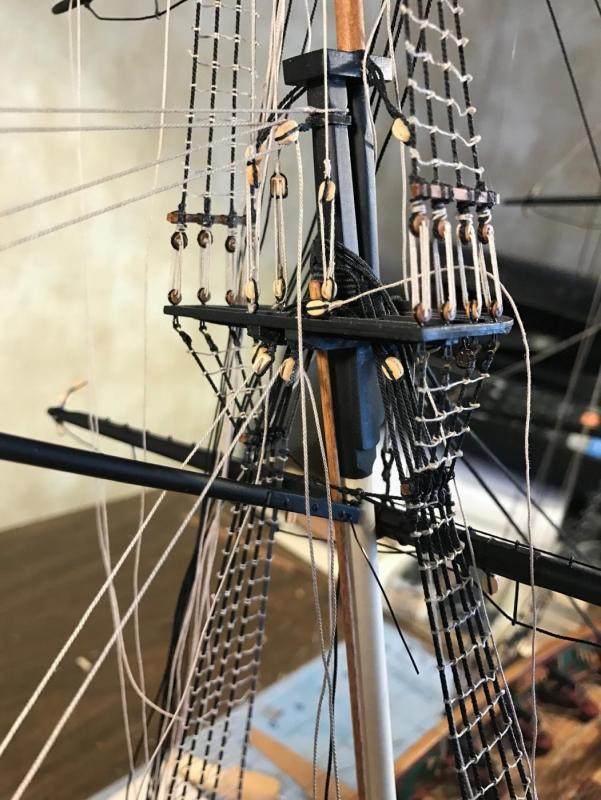
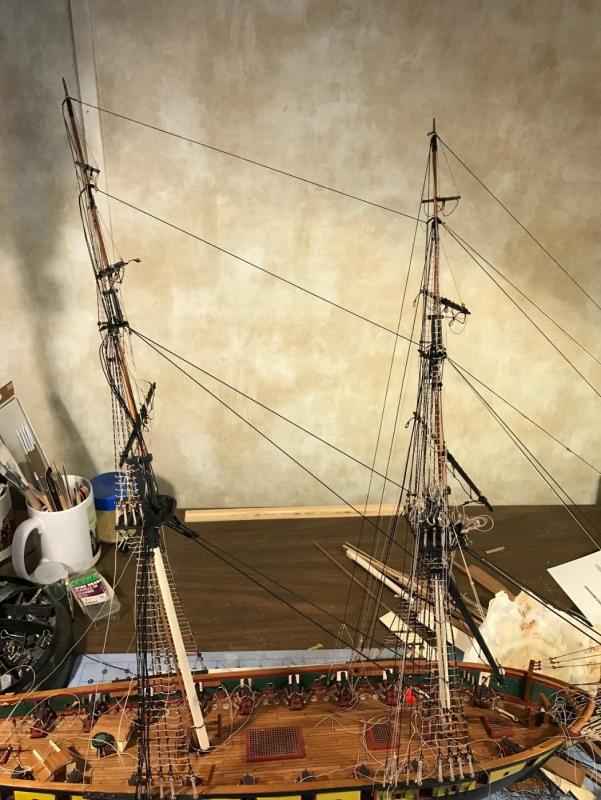
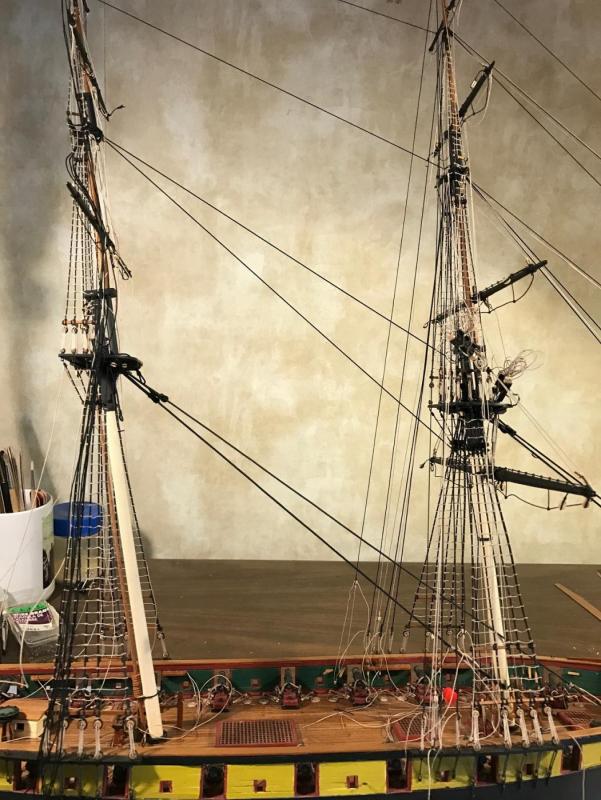

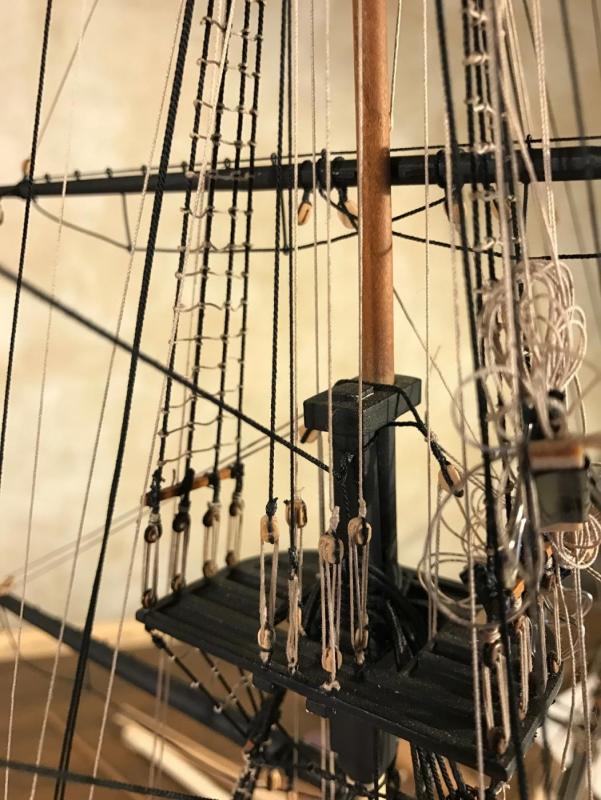
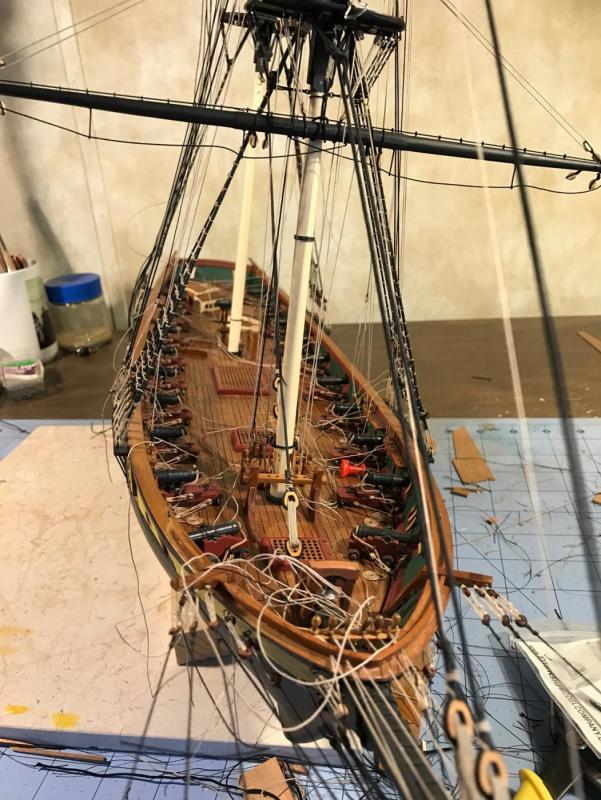
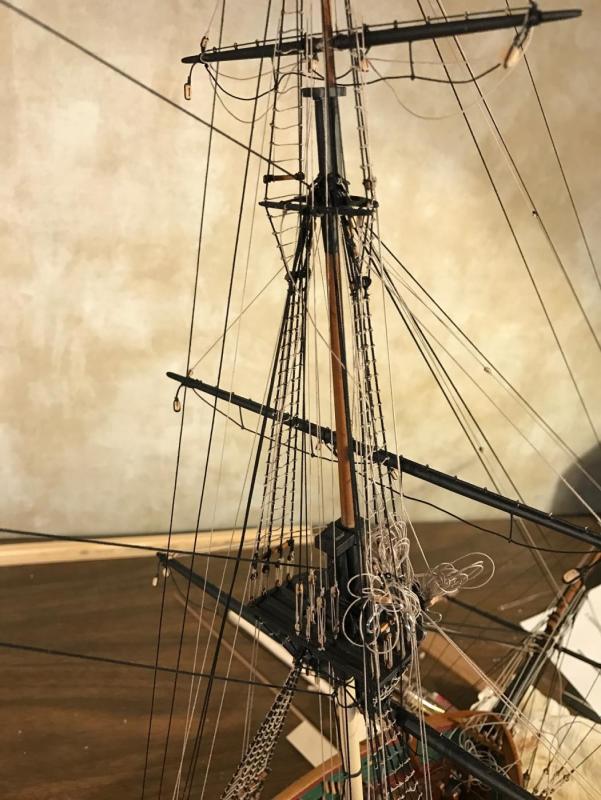
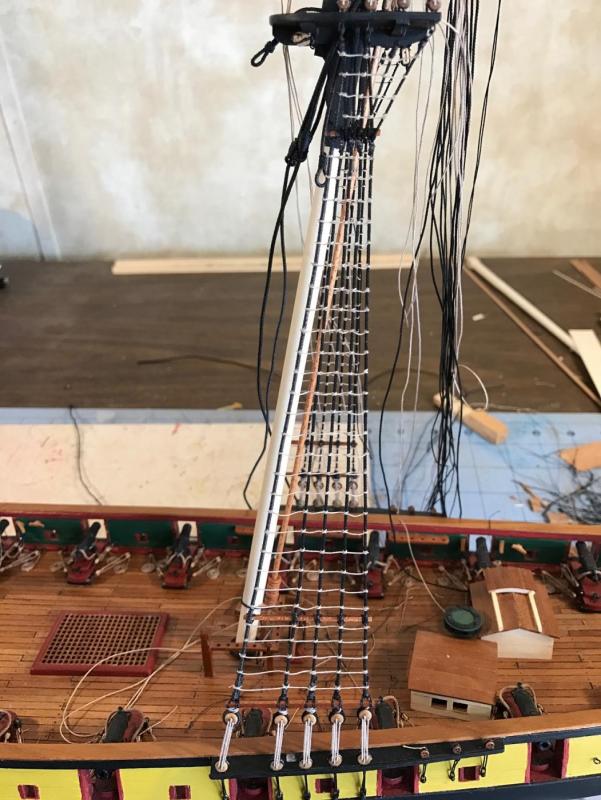
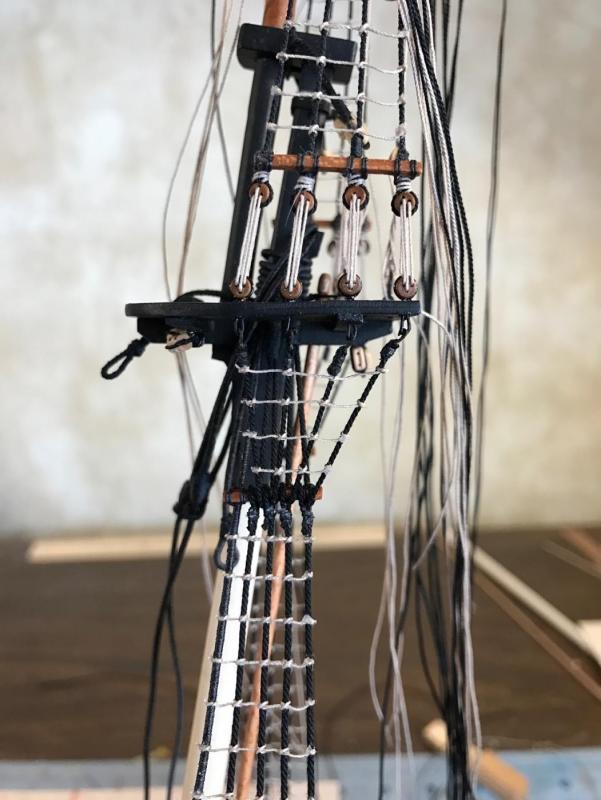
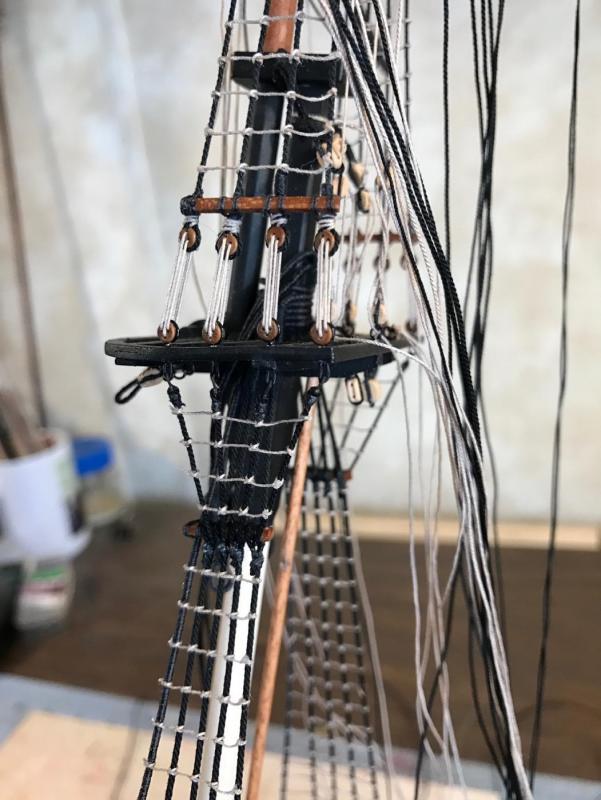
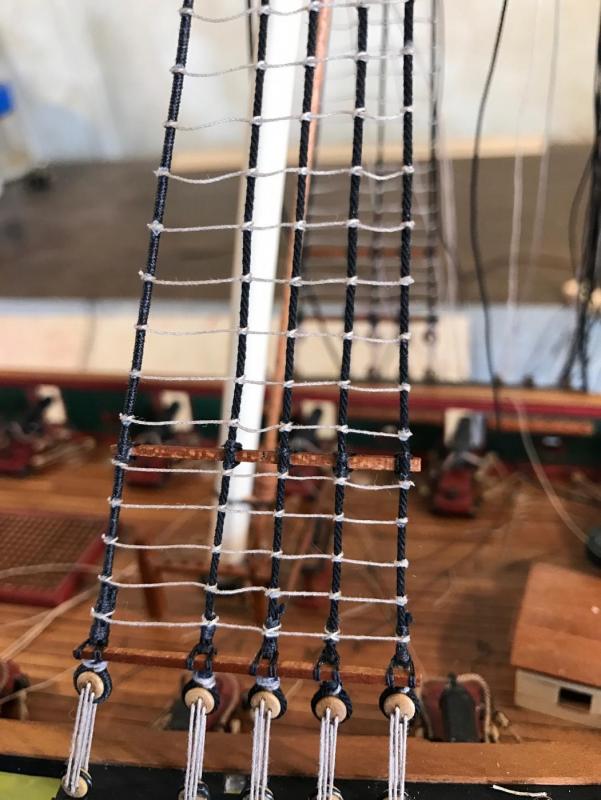
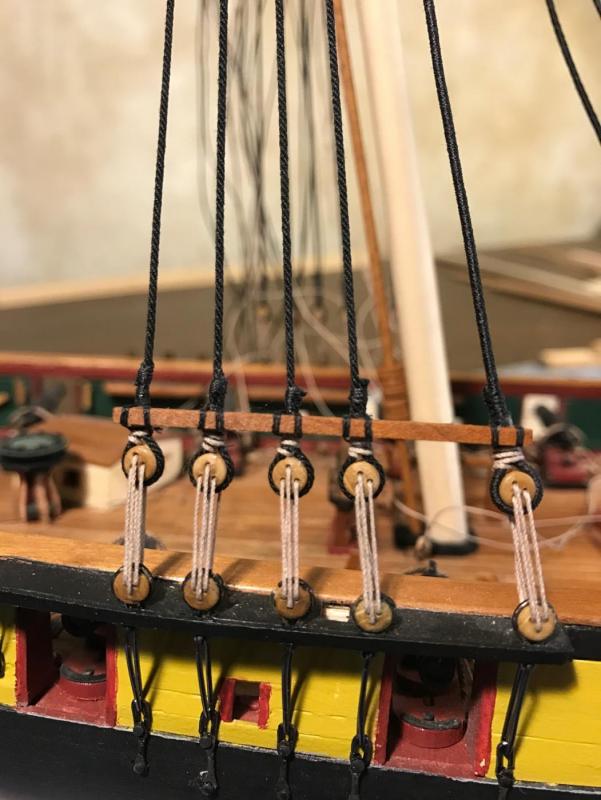
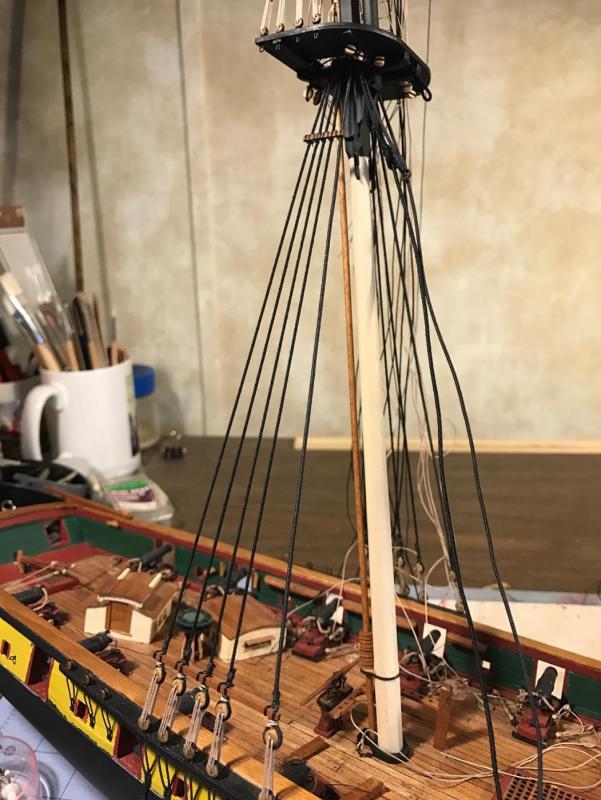
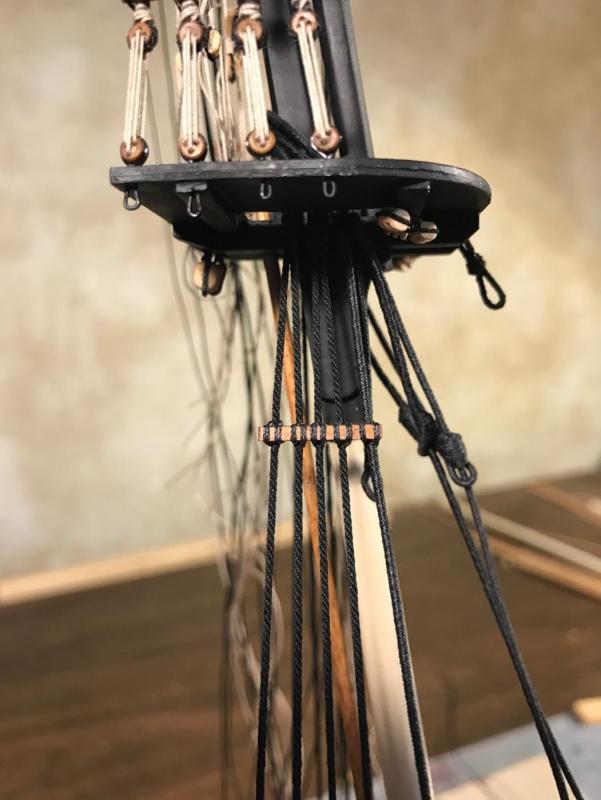
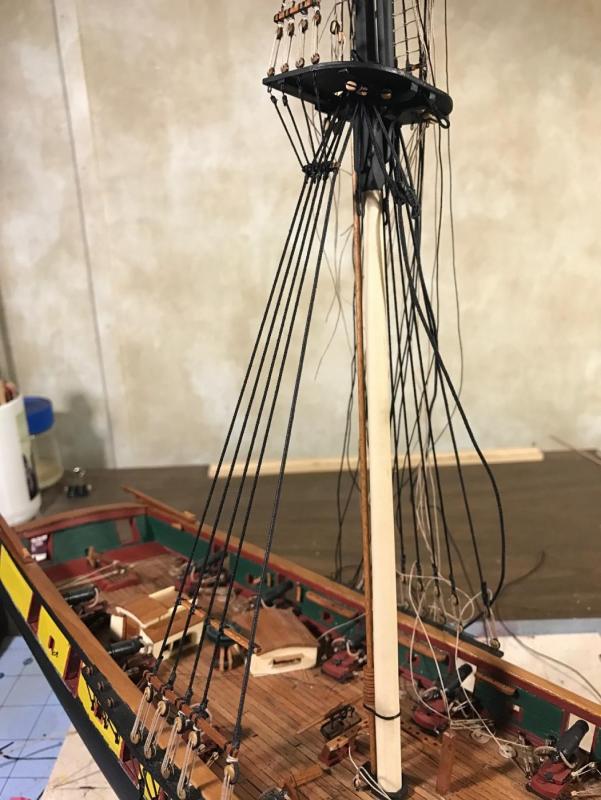
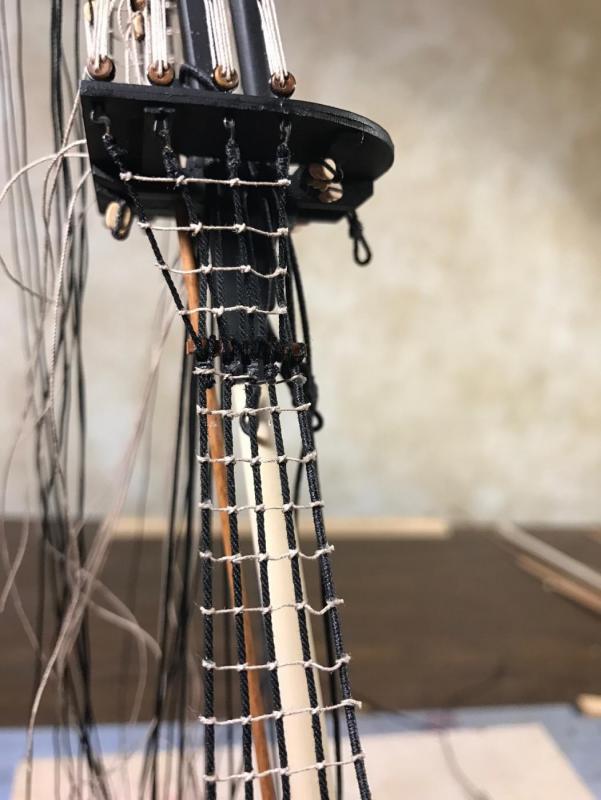
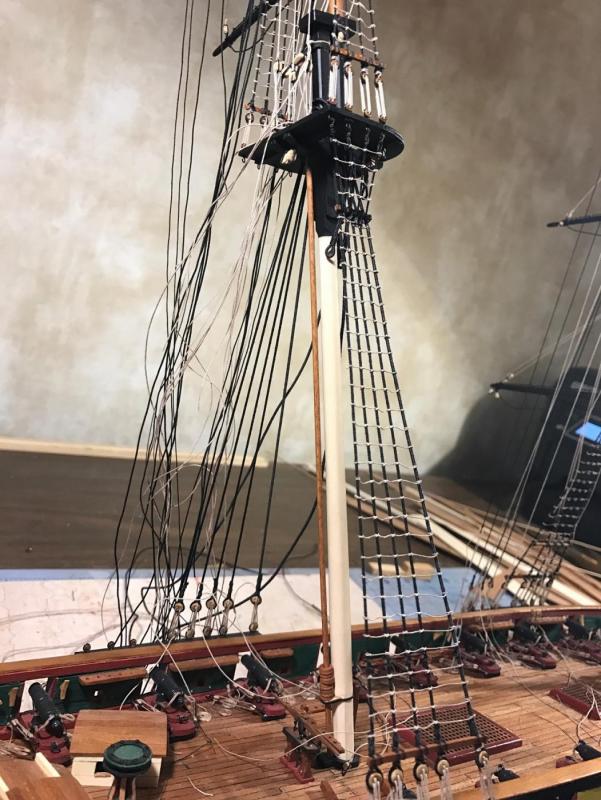
US Brig Niagara by 6ohiocav - FINISHED - Model Shipways - Scale 1:64
in - Kit build logs for subjects built from 1801 - 1850
Posted
Hey Elijah
Thanks for checking in. I use a very small drop of medium CA on all of the small whippings and ratlines. These knots are pretty good on their own, but the glue helps. Don't over do it however. On larger knots I use a diluted white glue, 50/50 glue-water. again, used sparingly, it will dry almost invisible.
The real key to the rigging is the rope and blocks that I purchased from Chuck at Syren. It makes my work look way better than it really is. If you can swing the additional cost, I highly recommend it.
And finally, practice makes (nearly) perfect. I have tied so many knots in the most confined areas, that I have figured out a thing or two.
My advice to my fellow Niagara builders at the cusp of starting the rigging process is to be bold and forge ahead. It is not as daunting as it may seem. The plans could be a bit better, but you will figure it out as you go, and of course, if you run into a jam, I am sure I already faced it, and figured out a solution to it which may not be the right one, but one that I will nonetheless be happy to share.